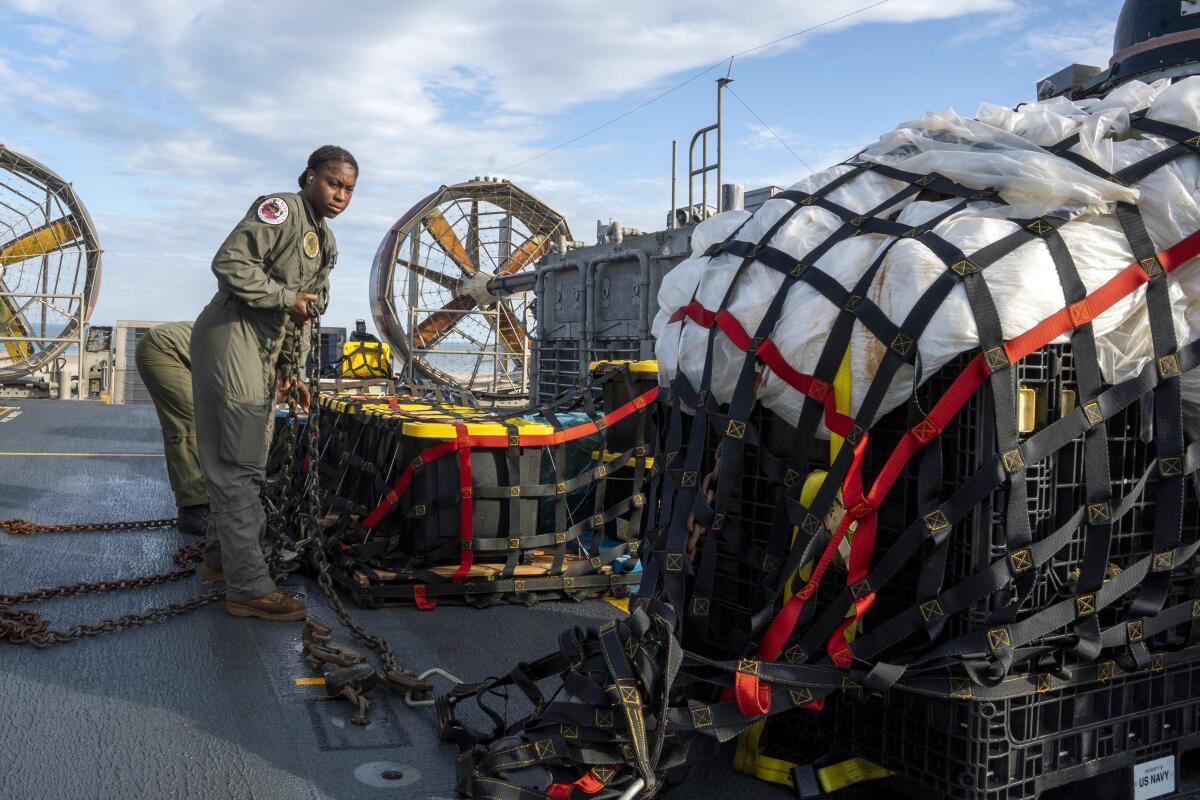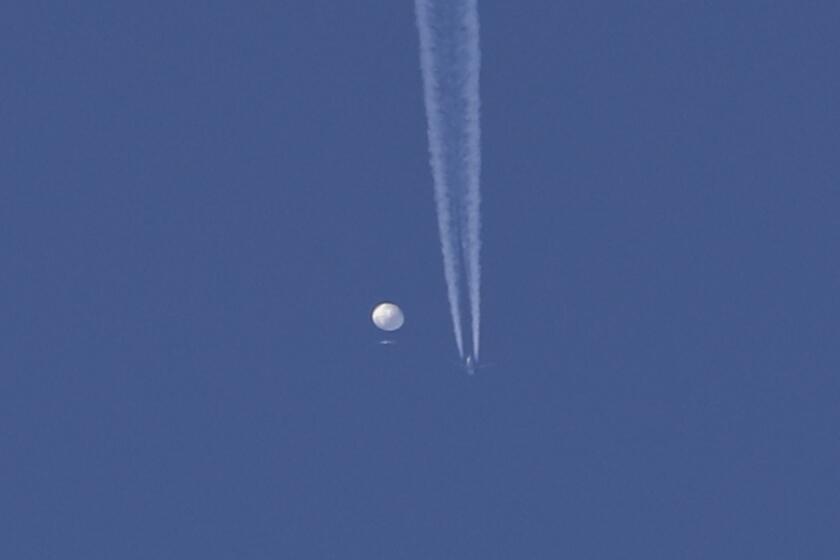Mystery aerial objects raise questions about national security threat

- Share via
WASHINGTON — As U.S. Navy divers and salvage crews plucked pieces of downed aerial objects from the Arctic Sea to the kinder waters off South Carolina, the Biden administration on Monday was racing to learn what the latest mystery vessels were and who launched them.
U.S. fighter jets shot down three unmanned aircraft over the last few days: one near Alaska’s remote frigid northern coastline on Friday, another over Canada’s Yukon region on Saturday and a third over Lake Huron off Michigan’s Upper Peninsula on Sunday.
Pentagon and State Department officials say they are confident that the balloon downed on Feb. 4 off the Atlantic Ocean coast — after it traversed the U.S. for 96 hours and had Americans on high alert and looking skyward — was part of a vast Chinese spy project.
Essential Politics
Get inside analysis, the latest political news and exclusive reporting from our award-winning journalists in your inbox twice a week. Sign up here.
But the last three flying objects, officials stressed on Monday, are different in appearance and technological capabilities. They are smaller and, unlike the Chinese balloon, unable to loiter or hover. At least two of the vessels have still-unspecified payloads, officials said, though they are not as large as that of the Chinese craft, which was about the size of three buses and carried surveillance equipment.
Though remnants are still being collected, administration officials said the latest unidentified flying objects could be weather balloons, mapping instruments or any of a number of non-hostile aircraft. National Security Council spokesman John F. Kirby told reporters Monday the latest objects didn’t pose a threat to people on the ground, and did not send communication signals or have propulsion capabilities. The objects were shot down because they flew at altitudes that could pose a threat to civilian commercial air traffic, according to Kirby.
“Efforts are actively underway right now at all sites to find what is left of those objects so that we can better understand and communicate with the American people what they are,” Kirby said, noting that Alaska and Canada’s remote terrain and winter weather conditions have slowed search efforts.
President Biden on Monday directed national security advisor Jake Sullivan to form an interagency group to examine the unidentified aerial objects and determine whether they posed safety or security risks, Kirby announced.
But the lack of detail from administration officials and Biden’s silence on the saga have prompted bipartisan criticism over how the White House has managed the situation.
The U.S. on Saturday downed a suspected Chinese spy balloon off the Carolina coast after it traversed sensitive military sites across North America and became the latest flashpoint in tensions between Washington and Beijing.
“What’s gone on in the last two weeks or so, 10 days, has been nothing short of craziness,” Sen. Jon Tester (D-Mont.) said Sunday on CBS’ “Face the Nation.” “The military needs to have a plan to not only determine what’s out there, but [to] determine the dangers that go with it.”
Sen. Tom Cotton (R-Ark.) said in a statement that the president “owes the American people an explanation, direct and on camera,” about the unidentified aerial objects and the steps he’s taken to protect U.S. airspace. He noted that Canadian Prime Minister Justin Trudeau had publicly addressed the issue.
Unanswered questions have also prompted speculation to percolate on social media over whether the flying objects have extraterrestrial origins. The conjecture intensified after a senior U.S. Air Force general overseeing the North American airspace said Sunday that he would not rule it out.
“There is no indication of aliens or extraterrestrial activity with these recent takedowns,” White House Press Secretary Karine Jean-Pierre said at the beginning of a news briefing Monday.
Meanwhile, Beijing claimed Monday that the U.S. had flown more than 10 high-altitude balloons through Chinese airspace in the last year. Foreign Ministry spokesperson Wang Wenbin said at a daily briefing the U.S. should “first reflect on itself and change course, rather than smear and instigate a confrontation.”
In response, the U.S. quickly denied that it uses balloons to spy on China.
“There is no U.S. surveillance aircraft in Chinese airspace,” Kirby said Monday. U.S. officials say their espionage capabilities are better than balloons or other objects that would violate Chinese sovereignty.
There are “no active tracks today” on additional balloons, but U.S. and Canadian authorities are still monitoring the airspace, Kirby added.
Pentagon officials said the sudden uptick in detection of unidentified aircraft over the United States comes from having stepped up security and tweaking radar capabilities. Many of the items floating in a crowded airspace have been largely ignored, the officials said, because they were not deemed a threat. The most recent objects were flying at roughly 40,000 feet or less, which could potentially pose a threat to civilian air traffic.
Defense Secretary Lloyd J. Austin III said the U.S. has not recovered any debris from the latest objects and reiterated that they were shot down out of an “abundance of caution.” He said U.S. policy on shooting objects out of the sky had not changed and the administration would determine its response on a case-by-case basis.
“The three objects taken down this weekend are very different from what we were talking about last week,” he told reporters after his plane arrived in Brussels for a NATO meeting on Ukraine. “We knew exactly what that was. A [People’s Republic of China] surveillance balloon.”
The episode surrounding the first balloon — U.S. officials say it hovered over sensitive military installations in the Midwest — provoked U.S. Secretary of State Antony J. Blinken to scrap a long-planned, high-stakes trip to Beijing. On his agenda was working to improve the fraught relations between the U.S. and China, but the espionage scandal has only inflamed tensions. State Department officials can’t say when the trip will be rescheduled, but it is not likely to be soon.
Communications between senior-ranking officials are all but frozen. When Austin telephoned his Chinese counterpart, no one answered the phone. From the State Department, only an assistant secretary has made a single contact, and that was last week before the latest round of aircraft shoot-downs.
Asked if the balloon episode had further hampered relations between Beijing and Washington, Kirby said it “certainly has not helped us move forward in the way that we want.”
More to Read
Get the L.A. Times Politics newsletter
Deeply reported insights into legislation, politics and policy from Sacramento, Washington and beyond. In your inbox three times per week.
You may occasionally receive promotional content from the Los Angeles Times.













